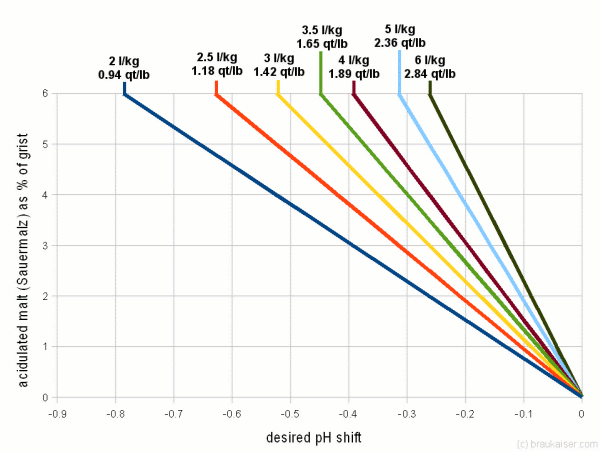acid malt
#1
 *_Guest_Matt C_*
*_Guest_Matt C_*
Posted 21 June 2010 - 07:34 PM
#2

Posted 21 June 2010 - 07:35 PM
#4

Posted 22 June 2010 - 01:12 PM
#5
 *_Guest_Matt C_*
*_Guest_Matt C_*
Posted 02 July 2010 - 10:35 PM
Can anyone explain this in a real working example? This diagram seems a little like an enigma to me. what are the varibles in using this malt over using just lactic acid? If I use say a pound (less/more) in a recipe, (i realize it depends on the recipe) but how can I be sure it will at least be close to the correct PH for full conversion? By the way I tried Kai's spreadsheet and thats not making much more sense either.There's a brief write up on Kai's site here, but this is the chart you need:
#6

Posted 03 July 2010 - 05:45 AM
pick a mash thickness (pick one of the colored lines), pick an amount of pH shift (x axis), and then see what percentage of your grain bill should be acidulated malt (y axis).ETA: I've never done this but that's how I would read that graph.Can anyone explain this in a real working example? This diagram seems a little like an enigma to me. what are the varibles in using this malt over using just lactic acid? If I use say a pound (less/more) in a recipe, (i realize it depends on the recipe) but how can I be sure it will at least be close to the correct PH for full conversion? By the way I tried Kai's spreadsheet and thats not making much more sense either.
#7
 *_Guest_Matt C_*
*_Guest_Matt C_*
Posted 04 July 2010 - 05:35 PM
Ok. understood,but what would the PH shift from??? My water PH or the mash PH? If its the water PH, my water sits at around 7.3 so that would mean about 2 points which is not even on the graph here, unless I am still misunderstanding.pick a mash thickness (pick one of the colored lines), pick an amount of pH shift (x axis), and then see what percentage of your grain bill should be acidulated malt (y axis).ETA: I've never done this but that's how I would read that graph.
#8

Posted 05 July 2010 - 05:08 AM
My guess would be the mash pH.Ok. understood,but what would the PH shift from??? My water PH or the mash PH? If its the water PH, my water sits at around 7.3 so that would mean about 2 points which is not even on the graph here, unless I am still misunderstanding.
#9
 *_Guest_Matt C_*
*_Guest_Matt C_*
Posted 05 July 2010 - 06:55 AM
Ok that makes sense. I was thinking in a recipe sense, in other words adding what you need before the mash. But in retrospect you really don't know how much to add until you mash in. What I usually do when checking the mash 1) is mash in,2) wait 10 mins,and then 3) check for the proper ph and then adjust accordingly. Instead of adding lactic acid, you add some cracked acid malt to adjust acid malt?My guess would be the mash pH.
#10

Posted 05 July 2010 - 07:53 AM
I would guess that's the way to do it but like I said - I've never done it so take this with a grain of salt.Ok that makes sense. I was thinking in a recipe sense, in other words adding what you need before the mash. But in retrospect you really don't know how much to add until you mash in. What I usually do when checking the mash 1) is mash in,2) wait 10 mins,and then 3) check for the proper ph and then adjust accordingly. Instead of adding lactic acid, you add some cracked acid malt to adjust acid malt?
#11

Posted 06 July 2010 - 11:11 AM
Become a patron.$5 ... cheap!... (Man, you don't get much time to edit your post, do you?)
#12

Posted 06 July 2010 - 05:09 PM
For commercial brewers they know what they need to add to get their pH right beforehand. For homebrewers, we adjust on the fly. If you want to try to figure out what your mash pH is going to be beforehand you can use John Palmer's Residual Alkalinity Nomograph in How To Brew to give you a ballpark estimate.Ok that makes sense. I was thinking in a recipe sense, in other words adding what you need before the mash. But in retrospect you really don't know how much to add until you mash in. What I usually do when checking the mash 1) is mash in,2) wait 10 mins,and then 3) check for the proper ph and then adjust accordingly. Instead of adding lactic acid, you add some cracked acid malt to adjust acid malt?
#13

Posted 09 July 2010 - 09:46 AM
Correct. If you want to adjust the pH after checking it in the tun, you decide how much you want to drop the pH, then add the required weight of Acid Malt, determined by your mash thickness and grist weight. So, if you're at 1.89 qt/# and want to drop the pH by 0.2 on a 10# grain bill, you would add 3% of your grist weight, or 0.3# of Acid Malt.If you want to predict how much to use, ahead of time, you need to use Kai's spreadsheet. Start filling it out with your values and you'll probably find it pretty self-explanatory and it will probably become clear as you have fewer boxes to fill in.What I usually do when checking the mash 1) is mash in,2) wait 10 mins,and then 3) check for the proper ph and then adjust accordingly. Instead of adding lactic acid, you add some cracked acid malt to adjust acid malt?
0 user(s) are reading this topic
0 members, 0 guests, 0 anonymous users









